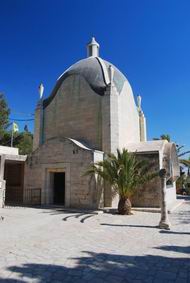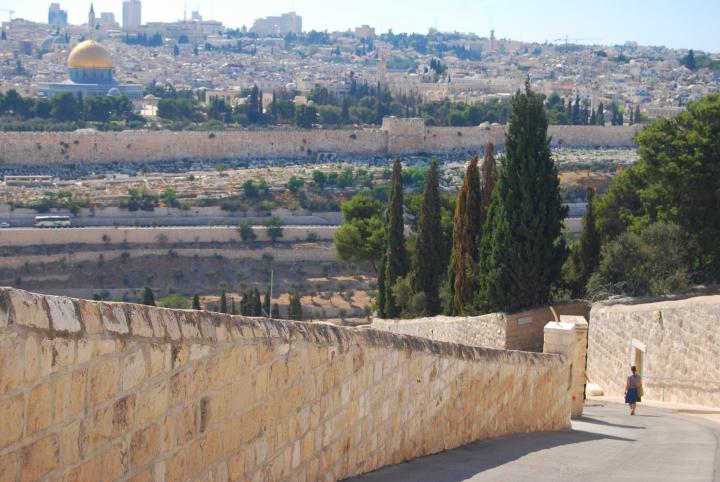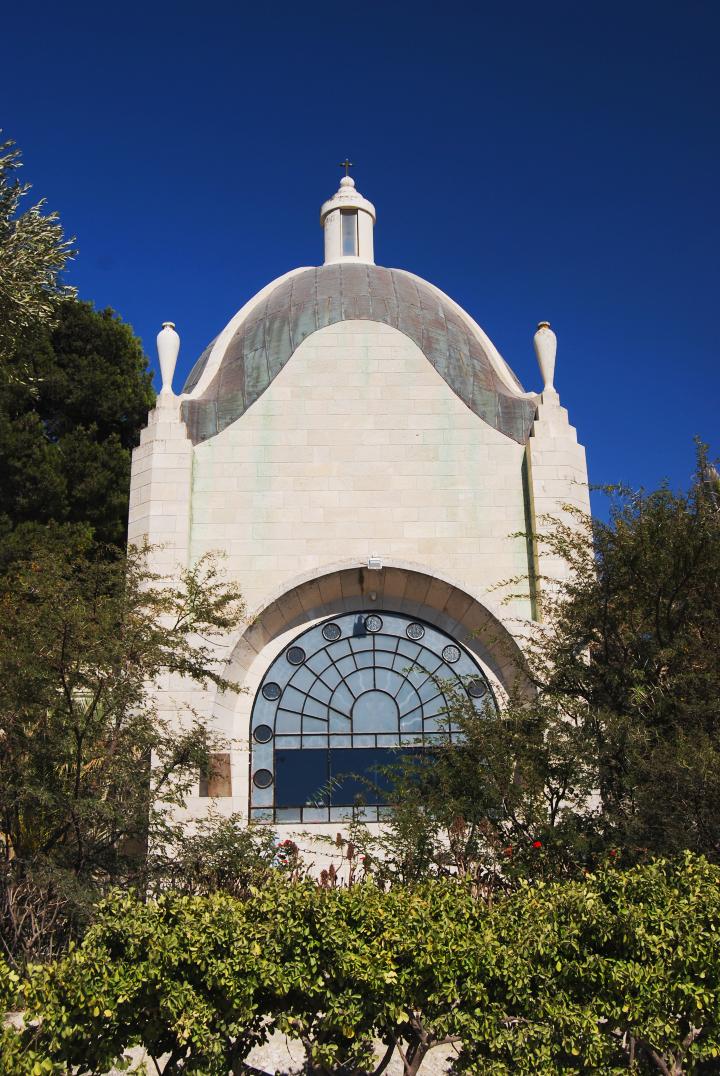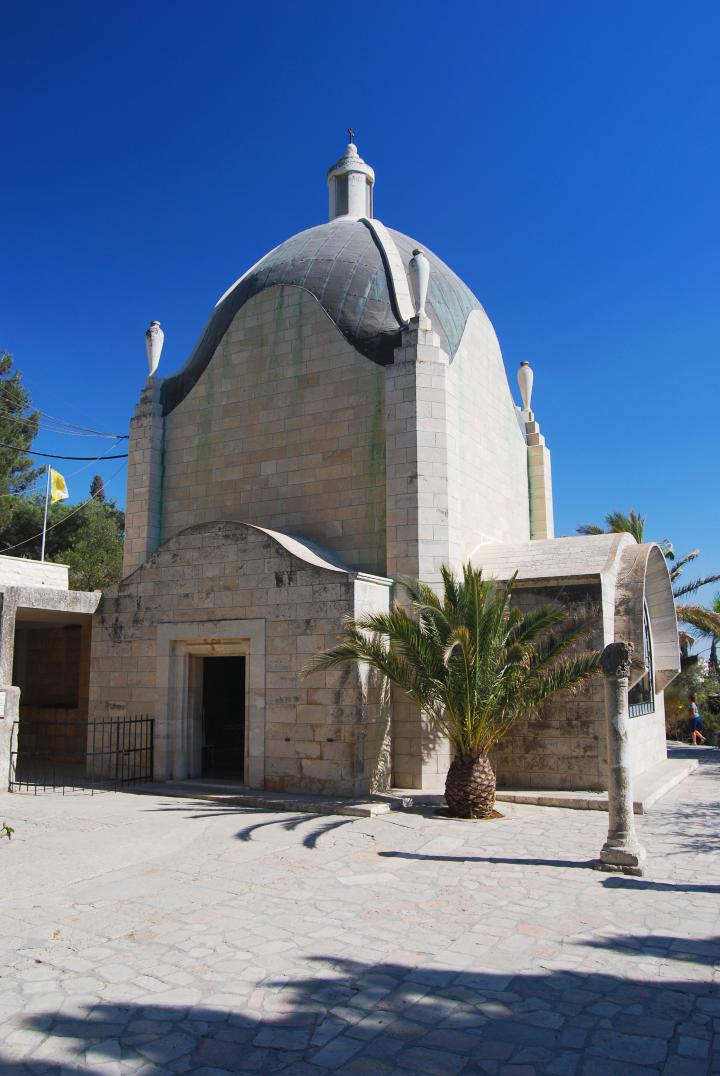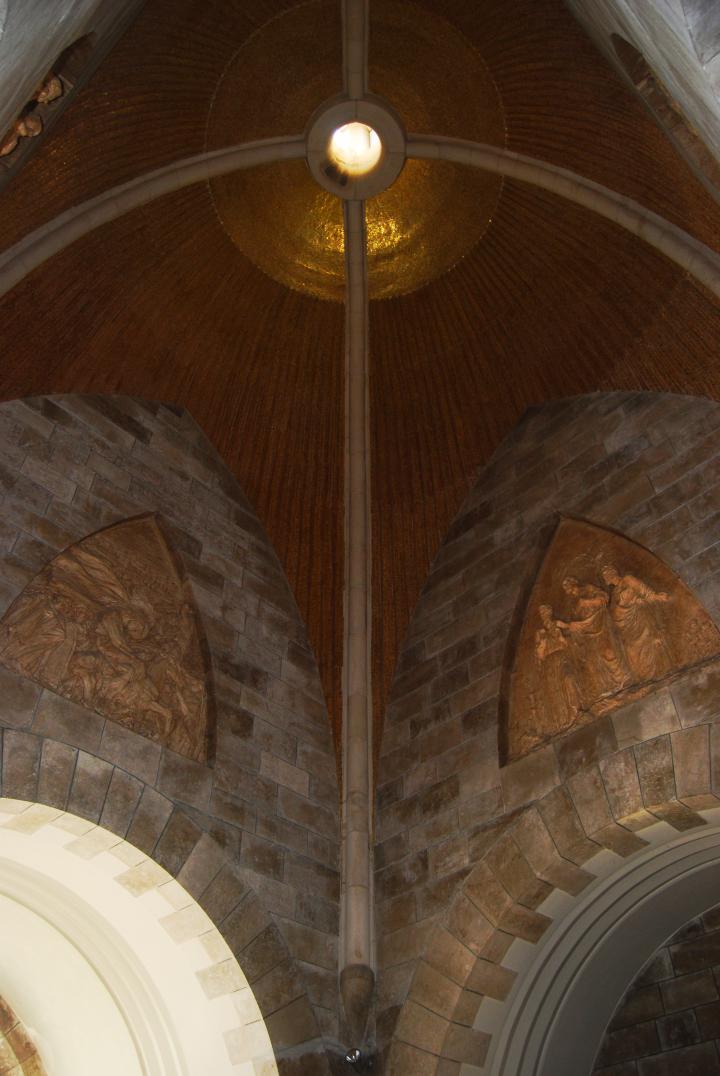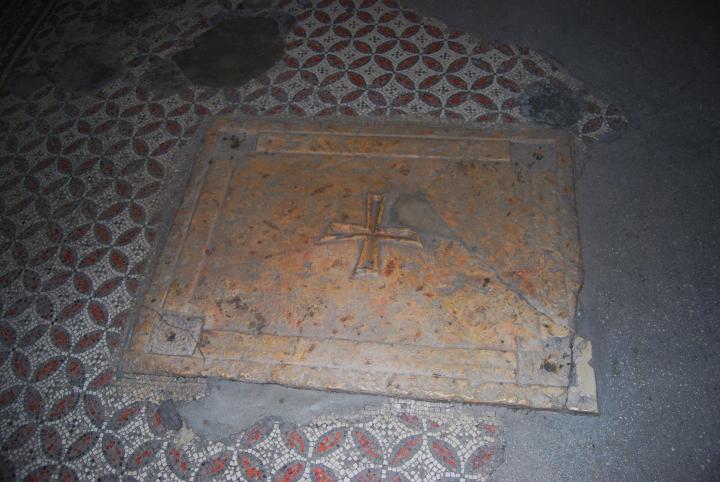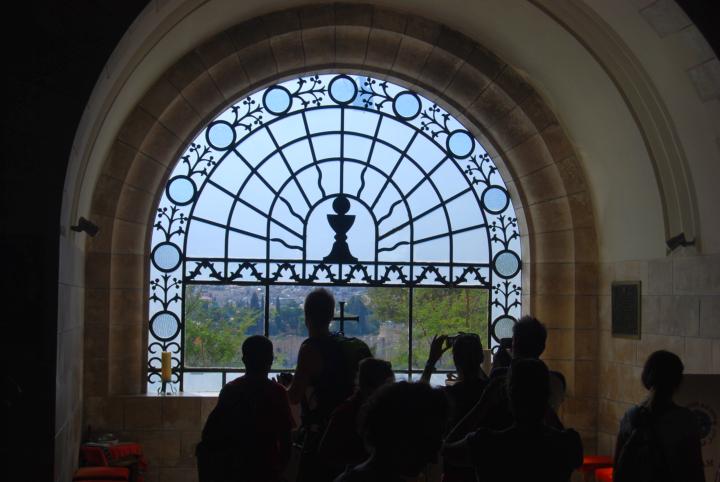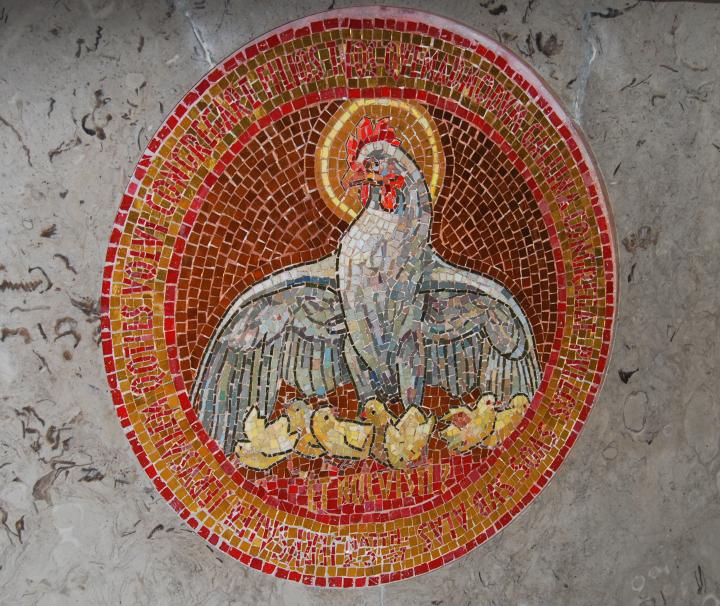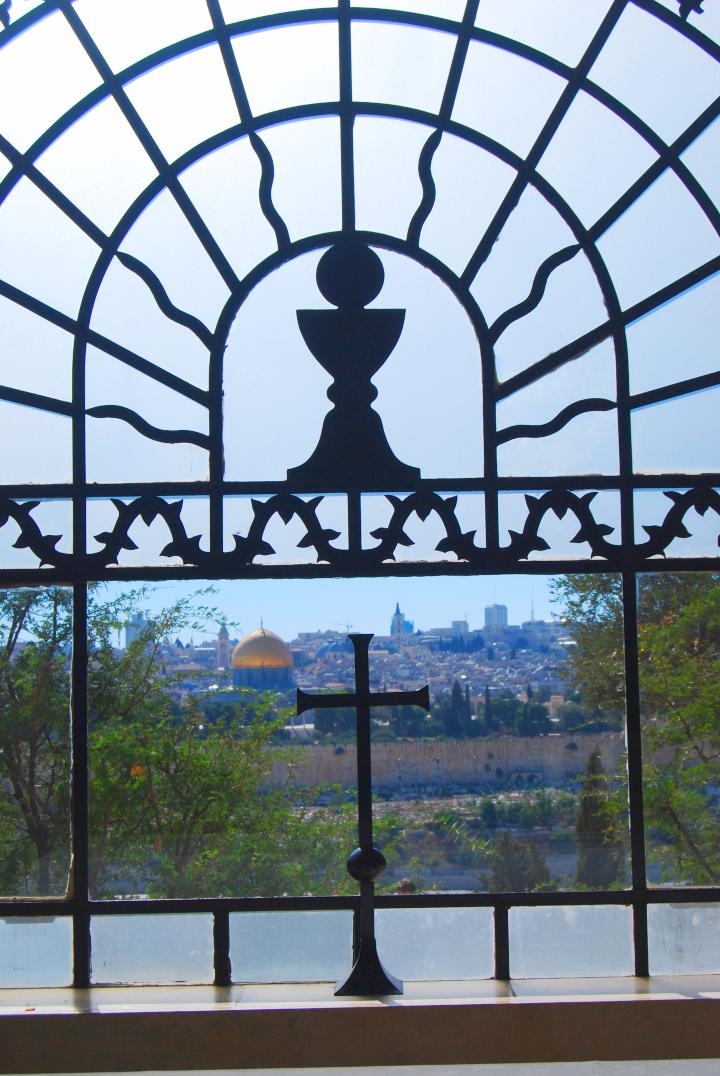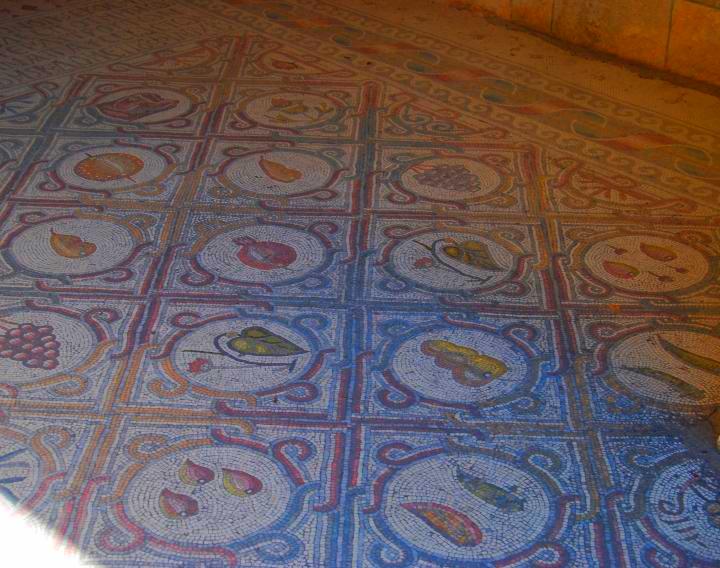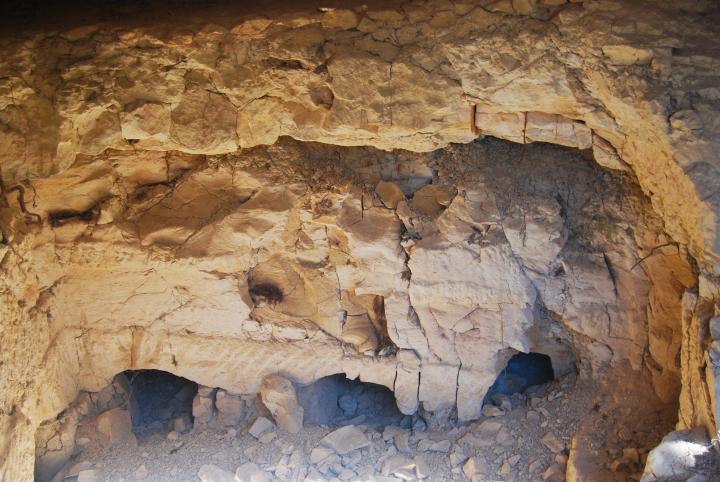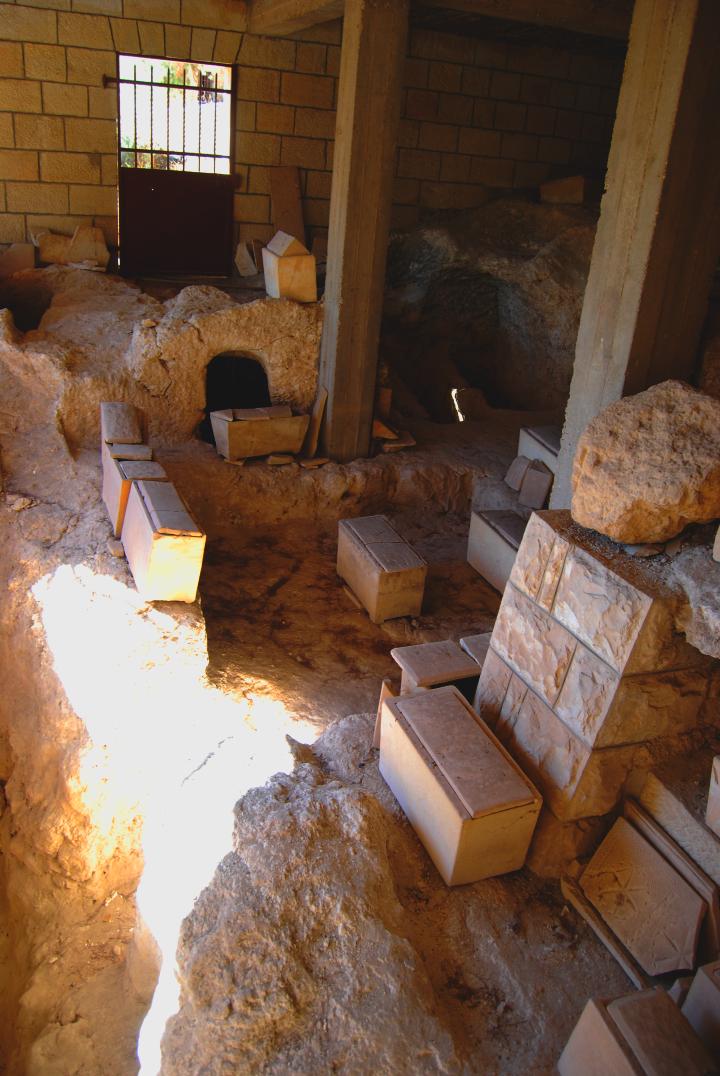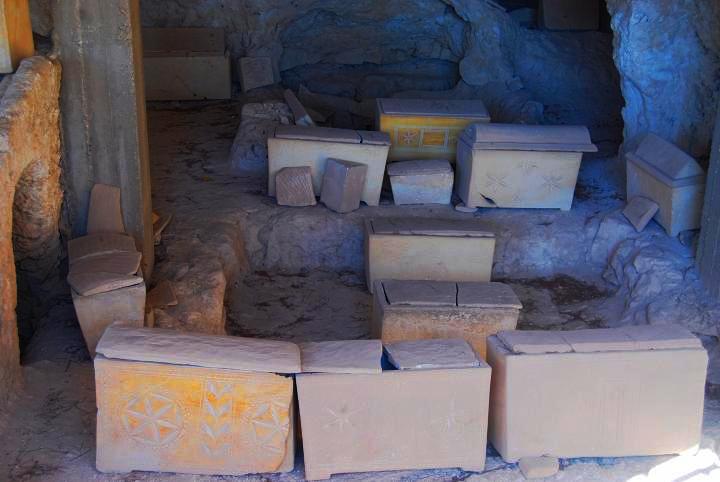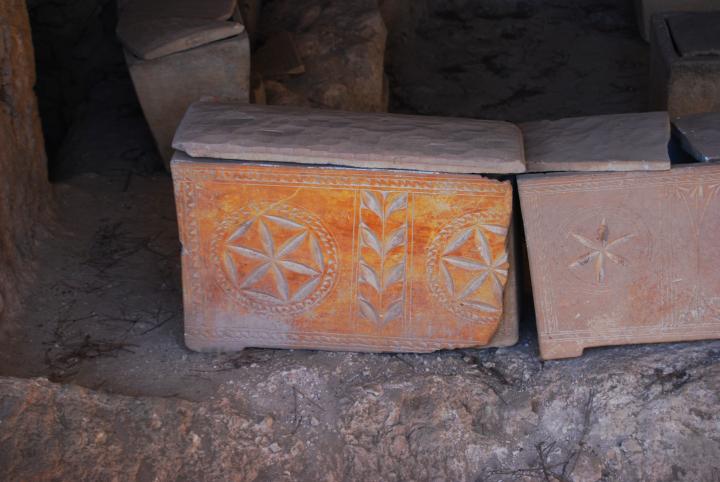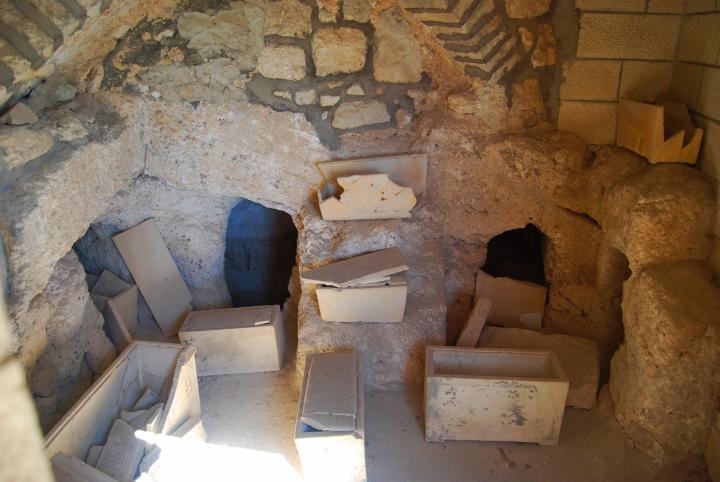A Catholic Franciscan church, on the foothill of Mount of Olives, where Jesus visualizes the destruction of Jerusalem and cries. The church is shaped as a tear drop. A Roman-Byzantine necropolis was also excavated at the site, revealing rich findings.
Home > Sites > Jerusalem > Dominus Flevit (“the Lord has wept”)
Contents:
Overview
Location
History
Photos
* General view
* Interior
* Altar
* Byzantine mosaic
* Burial caves
Biblical
Etymology
Links
Overview:
Dominus Flevit is a Catholic church located on the Mount of Olives in Jerusalem, near the Garden of Gethsemane. The name “Dominus Flevit” means “the Lord wept” in Latin, and refers to the Gospel account of Jesus weeping over the city of Jerusalem.
The church was designed by Italian architect Antonio Barluzzi and was built in 1955 on the site where it is believed Jesus wept over the city of Jerusalem during his triumphal entry. The church is shaped like a teardrop to symbolize Jesus’ tears, and its altar faces the city of Jerusalem. Luke 19, 41: “…he beheld the city, and wept over it.”
The interior of the church features beautiful stained-glass windows depicting Jesus’ life and ministry, as well as mosaics and other artwork. The church is a popular pilgrimage site for Christians visiting Jerusalem, as it offers stunning views of the city and provides a powerful reminder of Jesus’ love and compassion for all people.
A Roman-Byzantine necropolis was also excavated at the site, revealing rich findings.
Location:
The church is built on the lower western foothills of Mount of Olives, facing the old city of Jerusalem, on the eastern side of Kidron valley. It is accessed by foot through a steep walkway, from either the top of Mt olives or from the bottom near the Basilica of Agony and Mary’s tomb.
An aerial view is seen below showing the location of the church (in the center) and other points of interest.
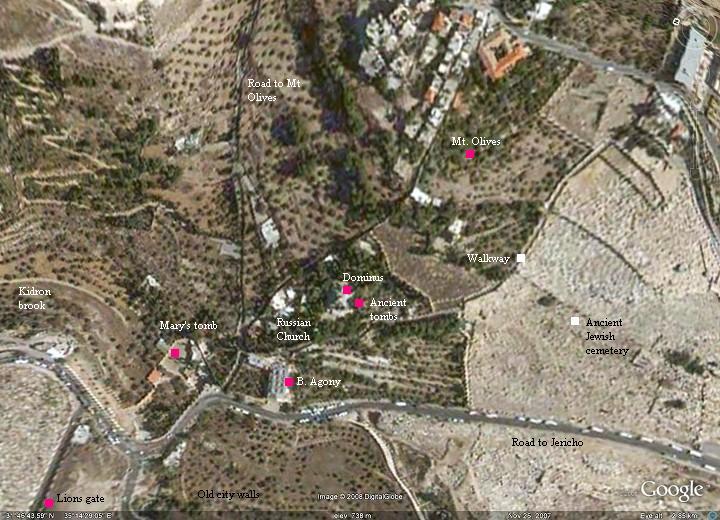
History of the place:
-
Bronze age
During the construction of the church, a late bronze tomb was found and excavated, with many findings.
-
Old Testament
Mount of Olives played an important part during the Biblical times. For more information – see the Mt Olives page.
-
Second temple period
There are several second temple period findings in the burial caves near the church (dated to 2nd century BC – 1st century AD). Near the entrance are two large caves with dozens of ossuaries (stone coffins) that are on display. The excavations resulted in other rich findings, such as a hoard of silver Jewish shekels minted during the Great revolt against the Romans (AD 66-70). On the coffins, mostly Jewish, are dozens of inscriptions in Hebrew, Greek and Aramaic.
-
New Testament
According to tradition, this is the site where Jesus was looking at the city, visualizing its destruction, and weeping over its fate. The location of the church fits the description in Luke 19 – on a descent from Mount of Olives and facing the temple mount.
-
Byzantine through Crusaders period
In the 5th century a Byzantine Monastery and chapel was built at this site. The present church is built over its ruins, and a mosaic floor can be seen to the left of the entrance. After its destruction in the Persian or early Arab period, the site was forgotten, and in the Crusaders period a small chapel was built here.
-
Mamlukes and Ottoman period
The Arabs converted the structure to a small mosque or school – named El-Mansuria (The Victory). After some time it was deserted until the 19th century. In 1913 a private house was built on the site.
A lot nearby was purchased by the Franciscans in 1891 and a small chapel was built. Later, they finally purchased the private house and the area where the church stands today. A new church was designed and constructed in 1953-1954. It was built over the ruins of the Byzantine monastery, but left traces of the ruins inside the church. During the construction, an Italian archaeologist – B. Bagatti – conducted the excavations. A small collection of the artifacts from these excavations are housed at the site.
-
Modern times
The church is open to the public, and many groups and tourists come to visit the church and pray. There is a great panorama from the balcony towards the old city and the foothills of Mt Olives, and although the access to the church is difficult – the view and the visit here is worth the efforts.
Photos:
(a) General view:
A steep road descends along the northern border of the huge cemetery of Mt. Olives, down to the Basilica of Agony and the Kidron valley. The old city walls are seen in the background.
The church is located half way down; its gate is just behind the person walking down the road.
Click on the photos to view in higher resolution…
This is the view of the church from the west side. It is structured as a tear drop in the form of a cross. It is a design of the Italian famous church architect, Antonio Barluzzi, who also designed other churches such as the Mount of Beatitudes, Visitation church in Ein Karem and Basilica of Agony. The church was built in 1954.
Another view of the church is seen below, captured from the north-west corner. The entrance to the mail hall is through this door, and on its left side is a Byzantine mosaic floor.
(b) Interior:
The photo below shows the dome above the eastern side of the small church.
The floor on the eastern side of the church is seen below, with fragments of the Byzantine church.
(c) Altar:
The altar is located on the western side, over viewing the old city. The window behind it frames a view of the old city behind it.
The mosaic on the altar has an illustration of a hen gathering her chickens, which is based on Luke 13, 44: “.. how often would I have gathered thy children together, as a hen doth gather her brood under her wings, and ye would not!”
Another view from the window that is facing the old city.
This orientation of the church is unusual, since most of the Christian churches face the east – towards Jerusalem or the rising sun. But here the orientation was set according to the direction of Jesus, when he was weeping over the fate of Jerusalem.
(d) Byzantine mosaic:
The church was built inside the ruins of a 5th-6th century Byzantine church, and incorporated some of its remains. A beautiful mosaic floor was left from the ancient church, and is located behind the entrance. It illustrates various fruits, as seen within the geometric patterns. There is even a piece of fish among the fruits. A Greek inscription behind, seen on the top-left corner, names Simeon as the person who laid out this floor: “built by Simeon and offered to Christ our Lord for the forgiveness of his misdeeds and for the rest of his brother, the Abbott George and Domitius friend of Christ”.
(e) Burial caves:
The church is located inside the ancient cemetery of Mount of Olives. There are thousands of grave stones and burial caves on the slopes of Mt Olives, where mostly Jews used to bury their dead for thousands of years hoping for a resurrection of the dead. During the construction of the church and excavations around it, many burial caves were found in the area of the church. They start from the Canaanite period – the Bronze age (with about two thousand findings), and span until the Byzantine period. Most of the rich findings from the early Roman period – the second temple period. On the ossuaries (stone coffins) are dozens of Hebrew, Greek and Aramaic inscriptions from the second temple period. One of the findings is a treasure from the period of the revolt against the Romans.
Three caves are shown below, and numbered in an order from north to south.
- Cave 1:
This cave is located to the north of the church, near the stairs that lead to a monastery above Dominus Flevit.
- Cave 2:
This cave is located near the entrance, and is the northern of the twin burial caves.
Another view of the burial cave and its stone coffins.
A detail of the coffin, with geometric forms and a form of a stalk.
- Cave 3:
This burial cave is the closest to the entrance, adjacent to cave #2. Here too are dozens of stone coffins, burial chambers and sarcophagi.
Biblical:
(a) Luke 19: 37-44
Jesus visualizes the ruin of Jerusalem, and wept on its fate and the ignorance (“Ignoratio” in Latin) of its citizens of the events to come.
“And when he was come nigh, even now at the descent of the mount of Olives, the whole multitude of the disciples began to rejoice and praise God with a loud voice for all the mighty works that they had seen; Saying, Blessed be the King that cometh in the name of the Lord: peace in heaven, and glory in the highest. And some of the Pharisees from among the multitude said unto him, Master, rebuke thy disciples. And he answered and said unto them, I tell you that, if these should hold their peace, the stones would immediately cry out. And when he was come near, he beheld the city, and wept over it, Saying, If thou hadst known, even thou, at least in this thy day, the things which belong unto thy peace! but now they are hid from thine eyes. For the days shall come upon thee, that thine enemies shall cast a trench about thee, and compass thee round, and keep thee in on every side, And shall lay thee even with the ground, and thy children within thee; and they shall not leave in thee one stone upon another; because thou knewest not the time of thy visitation”.
(b) Luke 13: 34
This text is inscribed on the altar, which illustrates the hen gathering her brood:
“O Jerusalem, Jerusalem, which killest the prophets, and stonest them that are sent unto thee; how often would I have gathered thy children together, as a hen doth gather her brood under her wings, and ye would not!”
Etymology (behind the name):
-
Har Hazeitim – In Hebrew: Har (Mount) Ha (the) Zeitim (Olives)
-
Shemanim – Hebrew – plural for oil.
-
Dominus Flevit – The name of the church, from Latin: The Lord has wept (based on the Biblical text: “…he beheld the city, and wept over it”).
-
Sarcophagus (sarcophagi in plural) – in Greek – flesh eater. A stone coffin, intended to be a multiple use box that contained the body of the deceased for the first phase. After the flesh decomposed the bones were removed to a smaller container or pit, allowing the next member in the family to be placed in the coffin.
-
Ossuaries -stone coffins
Links:
External Links:
-
Jerusalem Burial cave – names, testimony of early Christians
-
Archaeological museum – SBF
Internal links:
- Basilica of Agony – the Franciscan church on the lower foothills of Mt Olives, where Jesus prayed and wept.
- Check out our new pictorial presentation of the footsteps of Jesus.
BibleWalks.com – making the Bible
B. Agony<—previous Jerusalem site–<<< All Sites >>>—next Jerusalem site–> Ascension Chapel
This page was last updated on Mar 19, 2023 (new overview)
Sponsored links:
